Violence stalks America
By Charlene Muhammad -National Correspondent- | Last updated: Dec 18, 2012 - 10:21:58 AMWhat's your opinion on this article?
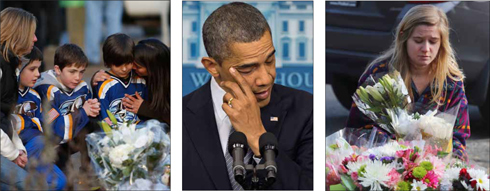
Killings of children in elementary school stuns a nation where extraordinary violence and grief that follows are more and more commonplace. Debates rage as country tries to grapple with tragedy, rage, gun violence and society on edge. |
A tragedy bring questions, pain and a search for answers
(FinalCall.com) - As funeral services began for the 20 children and six adults murdered at Sandy Hook Elementary School in Connecticut, the search for answers about how such a tragedy could happen and why dominated millions of hearts and minds.
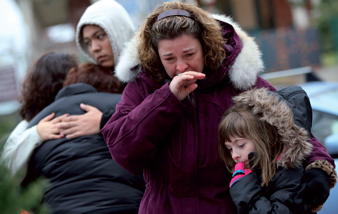
Mourners grieve at one of the makeshift memorials for victims of the Sandy Hook Elementary School shooting, Dec. 16, in Newtown, Conn. On Dec 14, a gunman allegedly killed his mother at their home and then opened fi re inside the school, killing 26 people, including 20 children. (AP Photo/Mary Altaffer)
|
While the true reason may never be known, from educators to school psychologists and activists the consensus was the impact of the brutal killings was clearly felt and would be long lasting. But observers and experts also said the personal tragedies also symbolized and were connected to America’s unfortunate historical and violent legacy.
Anti-racism activist Tim Wise reacted to news of the shootings as a father of two young children—one in a primary grade like many of the mostly six-year-old victims. He first thought about the pain caused to the families and the community.
“Secondly, I thought about how incredibly common this pain is all around the country, not just on these days when you have these mass murders but in communities where children are dying pretty regularly, whether it’s gun violence, child abuse or malnutrition or inadequate health care or whatever else,” Mr. Wise told The Final Call.
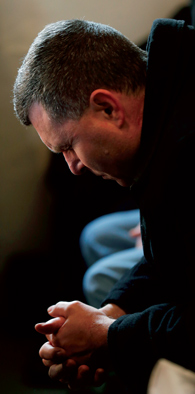
A man reacts during a service in honor of the victims who died a day earlier when a gunman open fi re at Sandy Hook Elementary School in Newtown, Conn., as people gathered at St. John’s Episcopal Church , Dec. 15, in Sandy Hook.
The massacre of 26 children and adults at the school elicited horror and soulsearching around the world even as it raised more basic questions about why the gunman, 20-year-old Adam Lanza, would have been driven to such a crime and how he chose his victims. Photos: AP Wide World Photos/Julio Cortez
|
Sadly, America’s a culture that just doesn’t place much of a premium on the lives of young people, he said.
In 2008 and 2009, nearly 5,800 children and teens were killed by guns, according to a recent report by the Children’s Defense Fund, a non-profit advocacy group.
The report, “Protect Children Not Guns 2012,” was dedicated to Florida teen Trayvon Martin and thousands of children and youth killed by guns each year. Mr. Martin, a 17-year-old Black male, was gunned down by George Zimmerman, a neighborhood watch volunteer in Sanford, Fla., in late February.
The number of children and teens killed was greater than the number of U.S. military personnel killed in action in Iraq and Afghanistan, according to the Children’s Defense Fund report. It further indicated:
• The number of preschoolers killed by guns in 2008 (88) and in 2009 (85) was nearly double the number of law enforcement officers killed in the line of duty in 2008 (41) and 2009 (48).
• Black children and teens accounted for 45 percent of all child and teen gun deaths in 2008 and 2009 but were only 15 percent of the total child population.
• Black males 15-19 were eight times as likely as White males of the same age and two-and-a-half times as likely as their Hispanic peers to be killed in a gun homicide in 2009; and
• The leading cause of death among Black teens ages 15 to 19 in 2008 and 2009 was gun homicide. For White teens 15 to 19 it was motor vehicle accidents followed by gun homicide in 2008 and gun suicide in 2009.
It is past time for people to demand the enactment of federal gun safety measures, insisted Marian Wright Edelman, president of the Children’s Defense Fund.
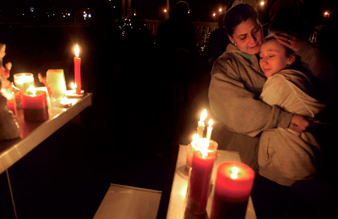
Brenda Hernadez of Enfield Conn., comforts her daughter Crystal at a makeshift shrine on the Enfi eld Town Green, December 14, after a candlelight vigil in Enfi eld, Conn. The vigil was organized by social media in memory of the school shooting victims in Newtown as residents in Enfi eld, 70 miles from Newtown, and throughout the state, feel the grief of the mass shooting at the Sandy Hook Elementary School. Photo: AP Wide World Photos/Journal Inquirer/Jim Michaud
|
“Why in the world do we regulate teddy bears and toy guns and not real guns that have snuffed out tens of thousands of child lives? Why are leaders capitulating to the powerful gun lobby over the rights of children and all people to life and safety?” Ms. Edelman asked.
Politics and crime
Debates about politicizing the shooting continued as photos and personal histories of the victims as well as 20-year-old alleged killer Adam Lanza trickled out in the news media. Some believe the problem was the alleged shooter’s reported history of mental illness that some say went unaddressed for far too long.
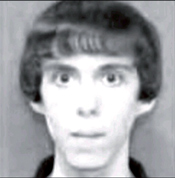
Adam Lanza Photo: MGNOnline/NBC
|
Many concurred with Ms. Edelman, saying America needs tighter gun control laws. And others felt if the incident and other mass shootings like it were called for what they are, acts of domestic terrorism, the government might do more to prevent them.
“I don’t know if it would change how often it would happen but I do think that people would be very quick to politicize it had it been an outsider, from outside the community. Let’s say, particularly if it had been a person of color, a person who was Muslim, or a person who was in any way sort of outside the norm, I don’t doubt for a second that there would have been a rush to politicize it,” Mr. Wise declared.
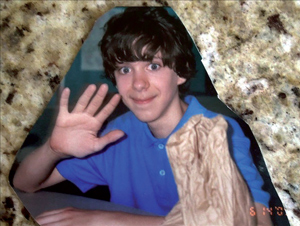
Photo of Adam Lanza that was taken when he was a middle school student at St. Rose Catholic School in Newtown., Photo: MGNOnline/courtesy Kate Foy
|
With the 9/11 tragedy in New York, 3,000 people died and it took all of five minutes to turn that into a political football, he noted.
“Even though I guess one could have said, ‘We should just mourn the dead and try to help them piece their lives back together, rather than going to war.’ We didn’t,” Mr. Wise pointed out.
He agrees that tragedy shouldn’t be made a partisan, political issue to prove who’s right, Democrats or Republicans. Clearly that isn’t helpful, but everything’s political, he continued.
“If you were being silent in the face of dead children, who are killed whether it’s by guns or inadequate health care or lead paint in their community, you’re making a political choice. Lives are lived politically. Our society is political and the choices we make that are political choices affect the degree, extent, number of dead children,” he added.
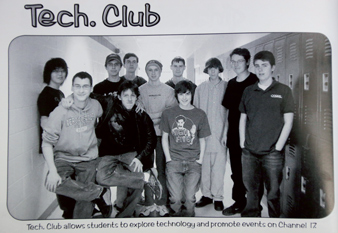
This undated photo shows Adam Lanza, third from the right, posing for a group photo of the technology club which appeared in the Newtown High School yearbook. Authorities have identifi ed Lanza as the gunman who killed his mother at their home and then opened fi re, Dec. 14, inside an elementary school in Newtown, Conn., killing 26 people, including 20 children, before killing himself. Richard Novia, a one-time adviser to the technology club, verifi ed that the photo shows Lanza. Photo: AP Wide World Photos
|
Activists note the time many pick to talk about solving gun tragedies always seems to be when one occurs—but that’s always too late.
In Aurora, Colorado in July, James Holmes killed 12 people and injured 58 others when he opened fire at a movie theater.
In Arizona in 2011, 24-year-old Jared Lee Loughner killed six people and wounded 13 others, including former Congresswoman Gabrielle Giffords, at a campaign event.
In Colorado in 1999, high school seniors Dylan Klebold and Eric Harris killed 12 students and themselves, and injured 21 others during an all-out assault at Columbine High School.
Talks on stiffer gun control laws remain necessary but only acting to change the laws might have saved their victims, activists note.
“Lives are at stake and we know that policy discussions, whether about gun control or terrorism is going to be the discussion we’re going to have. The idea we should wait five days, 12 hours or three weeks, how long should we wait?” Mr. Wise rhetorically asked.
No excuse for inaction
Since he’s been president, there have been four mass shootings, President Obama remarked during a Sandy Hook Interfaith Prayer Vigil on December 16. The president hugged survivors and consoled families. An endless series of deadly shootings have plagued America, he said.
“We can’t tolerate this anymore. These tragedies must end. And to end them, we must change. We will be told that the causes of such violence are complex, and that is true,” President Obama said.
“No single law—no set of laws can eliminate evil from the world, or prevent every senseless act of violence in our society. But that can’t be an excuse for inaction,” he said.
President Obama vowed soon to use his power to prevent similar tragedies. He pledged to work with law enforcement, mental health professionals, parents and educators saying there was no other choice.
Stigma of mental illness
Mr. Wise is worried that people will take the possibility that the alleged shooter was deeply, emotionally, psychologically disturbed and turn it into yet another way of stigmatizing mental and psychological illness. The reality is America has a problem, he said.
There is a lack of financial support and services for the mentally ill and mental illness is stigmatized as weakness, he said.
“We treat it like, ‘If you’re depressed, pull it together. If you’re sad, snap out of it.’ So instead we have people in need of services who are afraid to get them for fear of being looked at badly. If you had cancer, you wouldn’t say, ‘I’m afraid to get treatment for my cancer,’ ” Mr. Wise noted.
Communities like Sandy Hook, serene, upper middle class communities, have a special stigma attached to dysfunction and disorder because by virtue of socioeconomic status, racial identity, and geographic location, they’re not supposed to have problems, he argued.
‘I think if a kid in an urban community of color who was poor was manifesting the kind of real disturbing behavior that often times these shooters had been manifesting ... or even a White kid in an urban community, my guess is you would have cops see it, counselors would see it, teachers would see it, because those communities are constantly on the lookout for dysfunction because they’re not in denial about violence. They’re not in denial about disordered behavior,” Mr. Wise said.
“But when it’s White kids from ‘good families’ it’s almost like, ‘Well, I’m sure it’s a phase. It’s no big deal. He was sort of a geek but no big deal and 99 times out of 100 it will not be a big deal but you just can’t allow those assumptions that are rooted in race and class and geography and all those things to cloud your judgment,” mental illness cuts across racial, gender, and class lines, he told The Final Call.
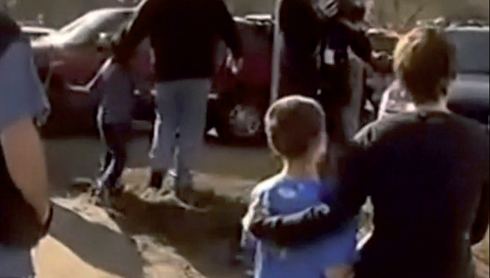
Parents escort their children after the Sandy Hook Elementary School shooting, Dec. 16, in Newtown, Conn Photo: MGNOnline
|
Logical reaction
“I think we should be empathetic because this is a horrific tragedy. I think many people will be overly sensitive and start to think there’s a way to lock down a school. You can’t lock down a school,” said Dr. Steve Perry, founder of Capital Preparatory Magnet School in Hartford, Connecticut.
Educators are afraid for their own safety but they’re more concerned about parents who enter schools on a regular basis, who are angry at the world, he declared.
“Because these are our children, we’re already afraid. There’s a healthy fear that runs through parenting. The problem is that when that fear becomes unhealthy it becomes paranoia. And there’s a sense of paranoia that I think is beginning to take hold of some people,” Dr. Perry told The Final Call.
Consider that 65 million people went to public school the day after the Sandy Hook shooting occurred but they were more likely to suffer a broken heart than a shooting, he argued.
“The most important thing that we can do is remind our children and families that they’re more likely to die in a car accident and from any number of other things than they are in their schools by gunfire,” he encouraged.
Dr. Perry believes there’s no answer for what happened, but still feels it’s reasonable to ask why. “If the shooter were still alive today and we asked him and he told us, there would be no solace in it,” he said.
Clandestine reasons
Dr. Umar Abdullah Johnson identified several possible surface triggers for the shooting: Mr. Lanza’s unaddressed emotional trauma for which he may have been medicated and unresolved issues with his mother, whom he also killed.
“My third pathway is a little bit more clandestine, which involves the CIA and the FBI. And that’s the MK ULTRA Mental Engineering programs that the United States Army, along with the CIA, FBI and the intelligence departments have been conducting at least since the 1940s,” Dr. Johnson said.
The program is a government, military project that seeks to engineer people’s minds so they can function as weapons, devoid of any type of human compassion, according to Dr. Johnson, a nationally certified school psychologist.
“I think we should be asking what type of psychological and psychiatric history does he have ... whether he was in the military ... what type of work his mother was involved in ... was he on medicine ... those questions will help to clarify a lot of stuff, as well as any political work up on the mom,” he said.
“Killing those 26 people could have been a cover-up to make him look insane for the killing of his mother if she was somehow political ... . If he was simply a sociopathic murderer, why didn’t he kill anybody else in that path? Killing the children didn’t make sense unless we’re missing pieces of the puzzle,” Dr. Johnson continued.
He, too, laments the deaths of the young victims and their educators, but argued there’s a responsibility to explore the political roots of the shooting. For instance, was it an intended diversion from the controversy of President Obama’s second term or the Israeli-Palestinian crisis, he questioned.
“The Israelis are over there killing children, families, blowing them up. America is supporting them. Is it possible that these children were killed to divert American’s focus away from the Israeli-Palestinian crisis and keep it here domestically? Was this done for international purposes? The only way you’re going to stop worrying about children being killed somewhere else is if they’re being killed in your backyard,” he argued.
INSIDE STORIES AND REVIEWS
-
-
About Harriett ... and the Negro Hollywood Road Show
By Rabiah Muhammad, Guest Columnist » Full Story -
Skepticism greets Jay-Z, NFL talk of inspiring change
By Bryan 18X Crawford and Richard B. Muhammad The Final Call Newspaper @TheFinalCall » Full Story -
The painful problem of Black girls and suicide
By Charlene Muhammad -National Correspondent- » Full Story -
Exploitation of Innocence - Report: Perceptions, policies hurting Black girls
By Charlene Muhammad -National Correspondent- » Full Story -
Big Ballin: Big ideas fuel a father’s Big Baller Brand and brash business sense
By Bryan Crawford -Contributing Writer- » Full Story






 Click Here Stay Connected!
Click Here Stay Connected!








